Ironwork
The Palais de la Porte Dorée is home to many ironwork decorations designed by renowned decorators, key figures in the artistic ironwork of the 1930s. Nowadays they can mainly be found in the circulation areas of the Palais.
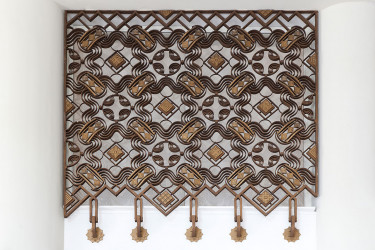
Legende
Detail of Raymond Subes' ironwork in the Hall of Honour of the Palais.
Credit
Photo : Lorenzo.
The Hall of Honour
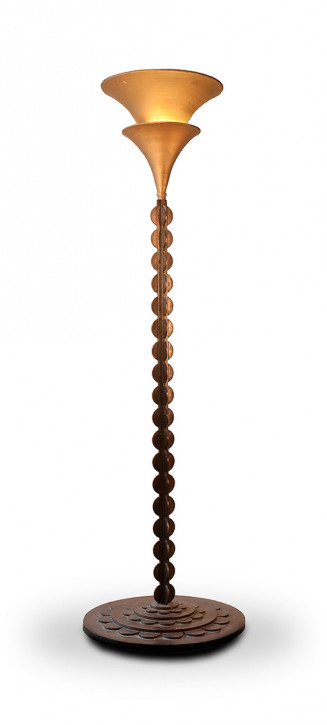
Legende
Subes floor lamp
Credit
Photo Lorenzo © Palais de la Porte Dorée
The Hall of Honour, the central space in the building, is particularly rich in decorative elements made from ironwork representative of the Art Deco style.
The first elements to be admired are the eight large lights made from forged iron with two bowls, arranged all along the French windows that illuminate the Hall of Honour. Specially created to occupy this space, where they have been since 1931, they were made by Raymond Subes (1891-1970), one of the most famous French artistic ironworkers of the Art Deco period, who also worked with the great decorators of his time, including Jacques-Émile Ruhlmann. Creator of a prolific body of work, a former student of the École Boulle and the École Nationale Supérieure des Arts Décoratifs, he notably created the stair banisters and the railings for the Île-de-France (1926), Lafayette (1930), L'Atlantique (1931) and Le Normandie (1935) ocean liners.
The shape of these lamps evokes the stylised silhouette of palm trees, with the two bowls symbolising the corolla of the leaves, while the stand with its curved forms resembles a trunk. They also echo the two table lamps designed by Eugène Printz, located in the Asia Salon.
Raymond Subes also created the latticed ironwork that looks over the centre of the Hall of Honour, made up of intertwined patterns, reminiscent of the moucharabiehs in Arab towns, from which one can see without being seen, while filtering the light. In its centre is the commemorative plaque, a reminder of the inauguration.
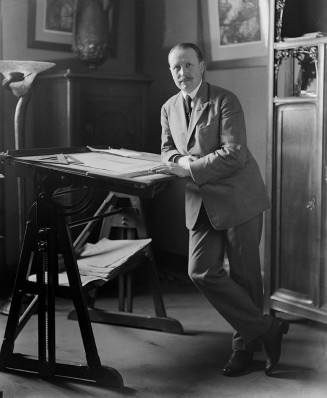
Legende
Edgar Brandt (1880-1960), artistic ironwork creator, on his drawing table.
Credit
© Laure Albin Guillot / Roger-Viollet
Still in the Hall of Honour, this same ethnic inspiration appears in the patterns on the transom grilles of the monumental French windows created by Edgar Brandt (1880-1960), the great artistic ironwork creator, whose workshop also produced light weaponry and household electrical appliances (with the famous Brandt brand from 1926). His gallery on the Boulevard Malesherbes, opened after he achieved success at the 1925 International Decorative Arts Exhibition, is considered to be the first decorative art gallery in Paris; he exhibited his artistic ironwork creations, furniture, decorative objects, sculptures and lamps in partnership with Daum and Lalique, along with works by other creators from the Art Deco movement, notably the animal sculptures of François Pompon, Édouard-Marcel Sandoz, Paul Jouve, Georges Guyot, and Gaston Suisse, who he helped to promote.
The Africa Salon
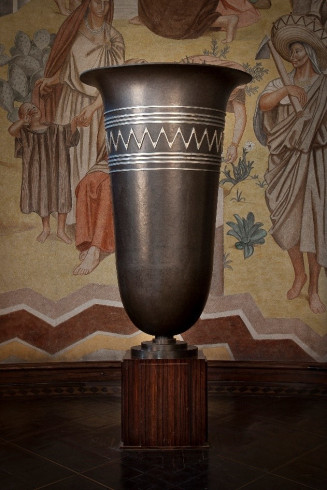
Legende
Vase éclairant de Raymond Subes
Credit
Photo : Lorenzo © Palais de la Porte Dorée ©ADAGP, Paris, 2021
The Africa Salon is also home to the two large vases éclairants made of embossed brass, designed and produced by Raymond Subes at the request of Jacques-Émile Ruhlmann, who designed the furniture for the salon, notably the Macassar ebony bases the vases rest on, made from the same wood as the other furniture in the salon. The zigzagging patterns around the vases echo the patterns on the decorative frieze at the foot of Louis Bouquet’s frescoes.
The shape of these understated vases was inspired by the model Ruhlmann created in Sèvres porcelain designed for the Île-de-France liner in 1926. Raymond Subes used this shape again for the winter garden at the decorators’ pavilion at the 1937 Universal Exposition.
The staircase
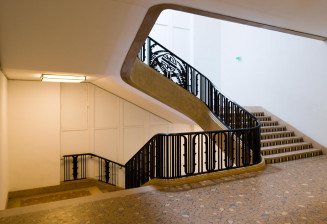
Central staircase
Photo C. Sancereau © Palais de la Porte Dorée
Each of the two central staircases comprises a banister decorated with scrolled patterns made by the Baguès ironwork company. The banister, which runs the entire length of the staircases from the Aquarium to the exhibition galleries on the top floor, with a length of 70 metres, is decorated with patterns that also resemble palm tree leaves and lyres inspired by tree trunks.
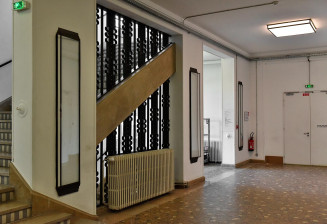
North staircase
Photo P. Lebruman © Palais de la Porte Dorée
In the rear of the building the North staircase is also decorated with vertical ironwork, designed by Gilbert Poillerat (1902-1988), director of the decorative iron studio for the Baudet, Donon et Roussel construction company, for which he designed tables, lights, gates and other decorative elements made from forged iron. In 1937, he created the entrance gates for the Palais de Chaillot in Paris.
The exterior
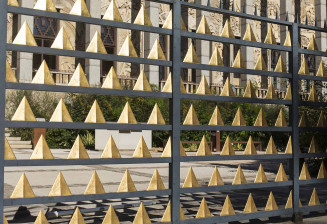
Grille Prouvé
© Palais de la Porte Dorée © ADAGP, Paris, 2022
Lastly, on the outside, between Avenue Daumesnil and the Palais forecourt, the main entrance gate made from forged iron decorated with gilded triangles made from fine gold (“diamond point” motifs) was designed by the famous artistic ironworker from Nancy, Jean Prouvé (1901-1984), who was also an architect and furniture creator. In the 1950s, he worked with Le Corbusier and especially with Charlotte Perriand, with whom he founded the École Nationale Supérieure de Création Industrielle (ENSCI - Les Ateliers) in 1982. As an architect, he was the first to introduce aluminium into building construction.



